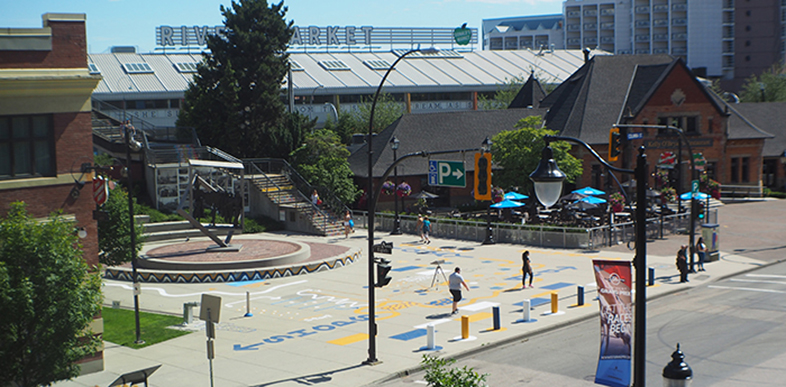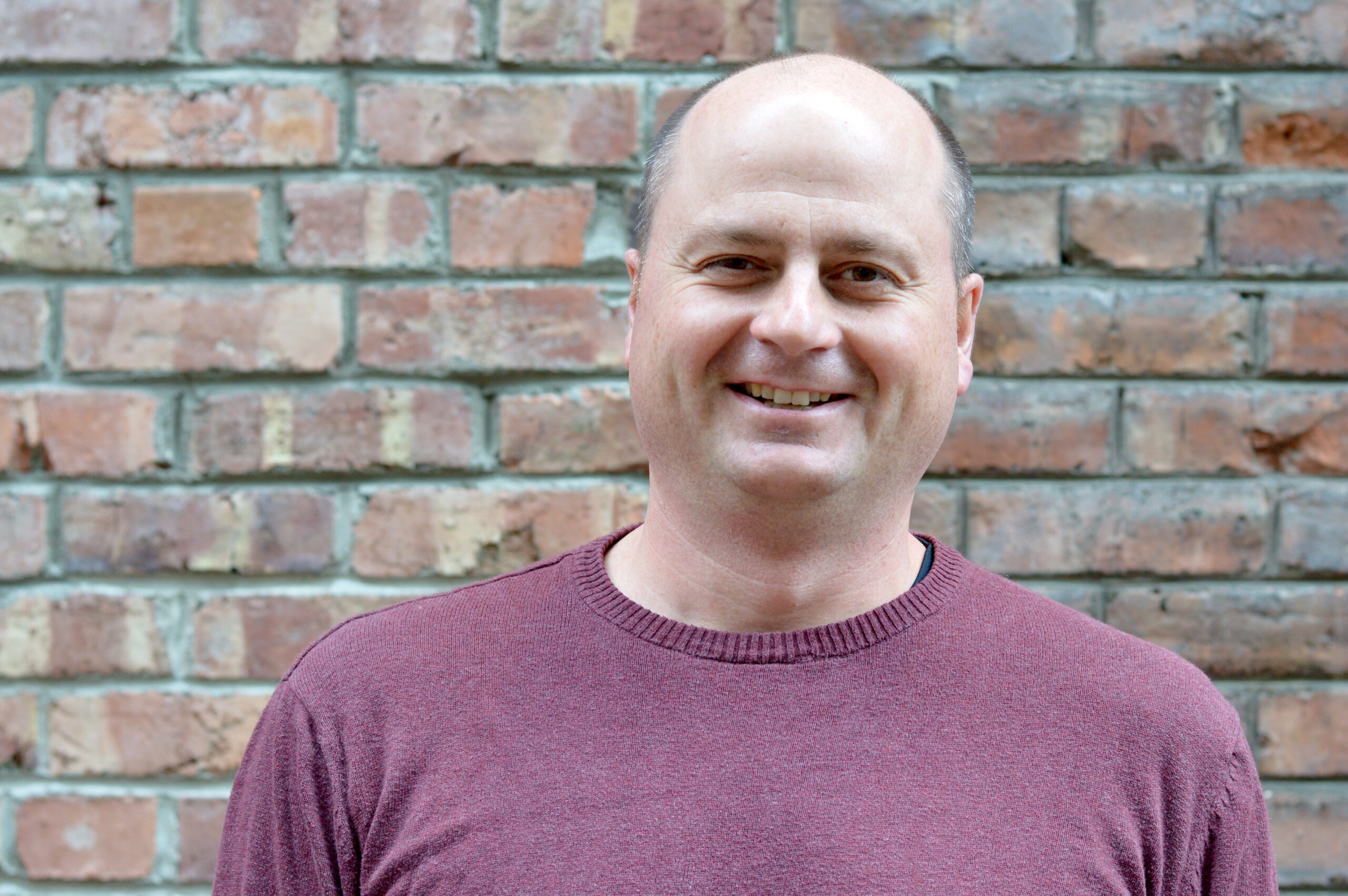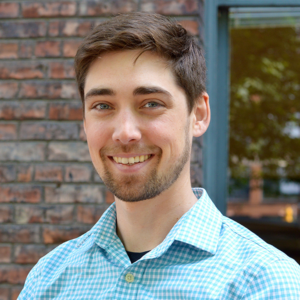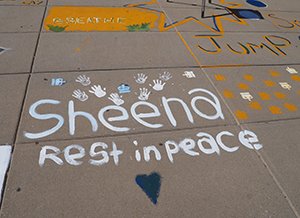Over the past decade, an exciting trend in urban design and transportation called tactical urbanism (or pop-up urbanism) has been gaining momentum around the world.
Even if the term “tactical urbanism” doesn’t ring a bell to you, you’ve probably experienced it in the town or city where you live.
It involves temporary changes to the built environment—flexible, short term projects meant to demonstrate what’s possible in public spaces.
Tactical urbanism normally uses simple materials like paint, tires and planters to quickly redefine a space in a temporary way so people can try it out.

It’s a quick way to get ideas off paper and test them in the real world—to pilot infrastructure and collect feedback before making permanent changes to a street or community. It’s a about doing as opposed to analysis paralysis—an action-oriented low cost way to change a space.

Sustainable Transportation Planner Jamie Hilland says he views tactical urbanism as fast, tangible way to create change in a community: “It shows what’s possible. It could be anything from a temporary pop-up bike lane, to thought-provoking artwork or transforming streets into public plazas or converting a parking space. People get to see what can be done, to imagine, open up and maybe to say hey let’s try this in a more permanent way.”
Community Planner Andrew Cuthbert adds that imagination is key. “Tactical urbanism is a powerful tool for getting people to envision their streets as being different. With a lot of our built environment its hardscape and so it’s hard to imagine change. Here we get people outside and say, ‘hey I know this is concrete and everything but we can still conceptualize it differently’—we get to break people out of their comfort zones.”
Tactical Urbanism Transforms Hyack Square

This past June, we were well represented at the the British Columbia Active Transportation Summit, and as part of the program Andrew and Jamie held a hands-on workshop explaining tactical urbanism, where and when it should be applied, policy and contextual considerations and the basics of how to make projects happen in a community.
Following this discussion, workshop participants worked to envision how to transform Hyack Square, a high-profile yet fairly gray, concrete, and impersonal space in downtown New Westminster, located just across the street from the conference. The square connects to waterfront shopping and is located on a busy street. For the last hour of the workshop, participants got outside and using paint, chalk and other materials, they transformed the square into a vibrant and friendly space for all. Participants used the colors of New Westminster to do some wayfinding, painted stairs and a bridge that crossed over railway tracks making a connection to the adjacent shopping area.
Here is some video evidence from the event in Hyack Square
“It was a great event,” says Jamie. “A lot of municipal staff rolled up their sleeves to help. It was a fun, ad hoc effort and a nice a way to really activate the community. We had lots of passersby joining to help, which we hadn’t anticipated. In the end, it was really well received and the city left it up for two months, which for a temporary pop-up is great.”
Public Space is Truly for Everyone
 While the transformation of Hyack Square was underway, a woman who had recently lost her daughter decided to approach.
While the transformation of Hyack Square was underway, a woman who had recently lost her daughter decided to approach.
“A woman approached us while we were working on the square,” recalls Andrew. “She was very fragile and had lost daughter recently. Yet, she felt comfortable coming up and asking if she could participate and if we could memorialize her daughter in the square by painting a memorial. We helped her paint her handprints into the square and wrote her daughter’s name in there. It made her really happy and made her day. It solidified the feeling that this public space really is for everybody and made it more personal. Ultimately, it gave our project even more meaning in transforming the space. It was pretty emotional for her and the team.”
There is a Magic in Simply Beginning
In the planning realm, most projects have multi-year lifespans. From consultation through to design and construction, the time between conception and completion can be many years.
Tactical urbanism is an exciting way to see instant results. “It opens you up to consider possibilities,” says Jamie. “I’m an impatient guy sometimes, and I love that with tactical urbanism I can roll up my sleeve and start to make things happen. It’s exciting sitting down with city officials. They are sometimes in confined lines of work, but this tool opens possibilities they may not be able to consider otherwise. We’re able to try something out, explore possibilities and have instantaneous results.”
Andrew echoes that statement. “As a planner, most of our work is long range. We’re looking at the future, 5, 10, 40 years down the road. Being able to create something in an afternoon is really powerful. In our world right now there’s pretty much a standard and accepted way that streets are made and how they look, but we’re at the beginning of a cool new wave of asking questions about whether that’s the way forward. We’re seeing a reconsideration of how streets are used and a willingness to try tactical urbanism in cooperation and coordination with the cities.
This shift from tactical urbanism being an outlier project to becoming an official part of proposals is exciting, says Jamie. He says that we’re all transportation planners, no matter our line of work.
“When we get up in the morning and figure out how to get our groceries or our job we’re all transportation planners. Ultimately tactical urbanism is a tool to helps us visualize how we can make our public spaces be more efficient and connected. For example, are our streets serving us best by being simply a way to move vehicles through quickly? Thirty to forty percent of our land is dedicated to moving cars around. That’s a huge draw on our land and it’s very expensive. Tactical urbanism allows us to explore questions like should we enjoy streets differently—as places to express artistically, or to walk or bike? It’s a whole renaissance of reconsidering our transportation system and how it fits into of our community. Through using tools like these, we’re quickly able to see the link between transportation and community, and that’s exciting.”
And as for the future of tactical urbanism? Jamie thinks it’s bright.
“I think you’ll see a transition toward cities encouraging this type of thing encouraging people to reimagine their streets and take ownership of them. We’re seeing more and more of a demand for our projects as ways to help cities visualize. It’s become a value-added component for a lot of our proposals and cities are really keen to use tactical urbanism as a hands-on tool. It’s exciting.”